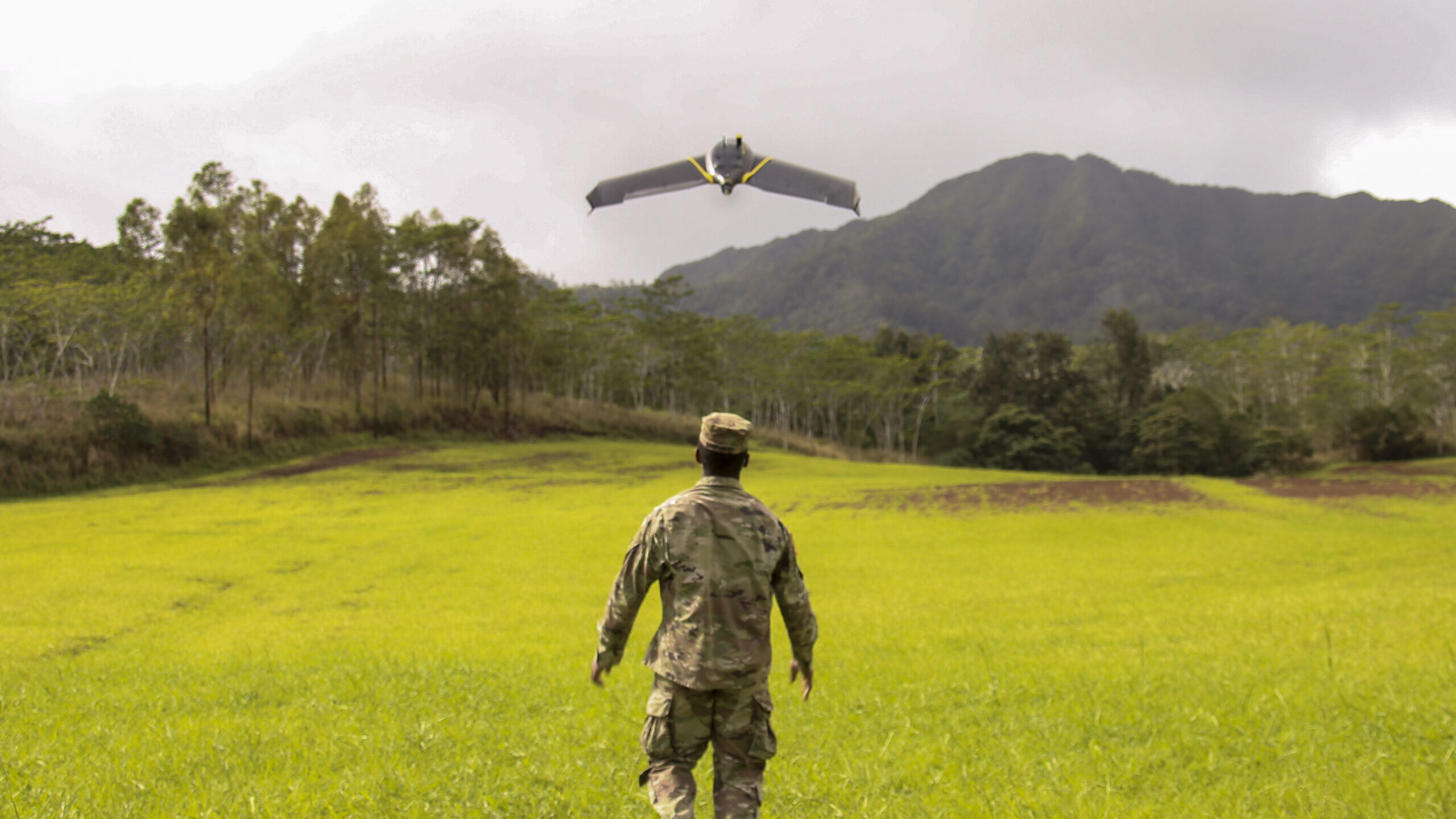
Military intelligence Soldiers with the 25th Infantry Division train on the One World Terrain drone and mapping system on February 4, 2021 at Schofield Barracks, Hawaii. (Staff Sgt. Thomas Calvert/US Army)
AUSA 2022 — Over the next fiscal year, the Synthetic Training Environment Cross-Functional Team, part of Army Futures Command, expects to run a series of major tests on its three key programs, aimed at helping the Army change how it trains for the fight of the future.
If the test are successful, those three programs — One World Terrain, Reconfigurable Virtual Collective Trainer and the IVAS-Squad Immersive Virtual Trainer — mark important progress on the Army’s delivering three of its top modernization priorities to soldiers.
One World Terrain is one of the STE-CFT’s most critical programs. The program provides soldiers with a three-dimensional terrain that can virtually replicate Earth’s terrain and can simulate the complexities of the operational environment. OWT integrates with the Training Management Tool and Training Simulation Software (TSS/TMT) to create the Synthetic Training Environment-Information System, which allows soldiers to virtually train at their point of need.
The program is on schedule to deliver a minimum viable capabilities release (MVCR) for squads, companies and platoons in the first quarter of fiscal 2023, according to Brig. Gen. William Glaser, director of the Synthetic Training Environment Cross-Functional Team.
“The capabilities include well-formed format (WFF) 3D and derivative data products for consumption by the TSS/TMT platform,” Glaser said in an email to Breaking Defense. “The scale, resolution and structure of the data will [enable squad/company/platoon] training in Q1FY23.”
Glaser said that One World Terrain is also on schedule to deliver MVCR to brigades and battalions in the fourth quarter of FY23. He noted that the OWT program and the TSS/TMT team are working closely together “to ensure the scope and quality of the data meet the MVCR requirements needed for BN/BDE (battalion and brigade).”
In FY23, Glaser said OWT will continue to deliver data for STE-IS/TSS/TMT fielding sites to support collective training. The program office also aims to increase automation in the system with new artificial intelligence and machine learning techniques.
Additionally, the OWT terrain team wants provide the intelligence and operational communities with One World Terrain, specifically for mission command needs. It also plans to work with other organizations within both the Army and the joint force to “lay the framework for a common environmental representation in support of CJADC2,” Combined Joint All-Domain Command and Control, referring to the Pentagon’s future warfighting construct.
The OWT software is also playing an important role at the Army’s annual Project Convergence experiment, an Army-hosted event that seeks to connected disparate joint and coalition systems. According to Glaser, OWT will support “systems requiring highly-resolved, accurate geospatial data for maneuver, autonomous systems and IPB [Intelligence Preparation of the Battlefield].”
This past fiscal year, the OWT delivered about 2 million square kilometers of 3D datasets to a range of partners, supporting training, operational, and intelligence needs.
“This includes support of the Afghan Airlift mission in Kabul, as well as support to the European theatre and our NATO allies,” Glaser said.
In the last year, he added, that “biggest improvement” made to the OWT pipeline has been the speed at which data is requested and delivered. The OWT team’s partners at the Army’s Geospatial Center, the National Geospatial-Intelligence Agency and Maxar have been able to “expediate deliver of high-fidelity datasets to the point of need,” he said.
“The automation of the workflow has also increased, and required fewer and fewer humans in the loop when producing terrain for the training community,” Glaser said.
RVCT Updates, IVAS Remains In Limbo
Another signature program in the Synthetic Training Environment team’s portfolio is the Reconfigurable Virtual Collective Trainer (RVCT), a mobile, transportable virtual training system that will allow soldiers and Army aviators to virtually train together. In August, the RVCT-Ground systems successfully integrated more than 157 dismounted soldiers while supporting company training during an operational assessment.
The RVCT program is currently working towards a rapid fielding decision in December of this year and if approved, then production will begin, Glaser said. Rapid fielding would be followed by continued integration with the Synthetic Training Environment-Information System as the program prepares for its initial operational test and evaluation in August next year.
The program’s operational assessment in August “put the RVCT-Ground in a good position and will inform the decision for the rapid fielding,” the one-star said. During that assessment, second generation hardware — developed by soldier feedback — was tested and ultimately accepted by soldiers, he said.
If the RVCT-Ground gets the nod to begin rapid fielding, Glaser said the next step is to “inform” the same decision for RVCT-Air and begin the production of systems needed for the operational demonstration next summer.
“RVCT remains on schedule and has successfully accomplished all milestones to date,” Glaser said. “We foresee no challenges with the programs successful IOT&E/Operational Demonstration in Aug 23.”
The last program, the IVAS-Squad Immersive Virtual Trainer, is a collective training system that will integrate with IVAS in the future. The STE-CFT did not provide updates for IVAS, as the Army continues to decide the future of the Microsoft-made IVAS system.























